CHAPTER 17
Distributing Your Production
One cell phone can now simultaneously feed real-time video to the entire world. This, quite honestly, blows my mind. There is real opportunity out there and it’s available now. Virtually all of the media playing fields have been leveled.
Frank Beacham, Producer and Writer
Traditionally distribution was not a part of the production personnel’s problem. They created the content … and someone else worked to get it out to the audience. However, today distribution often becomes part of the role of the production personnel. Once the production has been completed, production personnel often need to burn it to a DVD or Blu-Ray disc, post it online, or stream it. Distribution depends on where you are sending it since the devices viewers watch their programming on are varied: televisions, tablets, computers, and mobile phones.
Key Terms
■ Bonded cellular: The merging of multiple cellular channels to increase the quality of the transmitted video.
■ IPTV: Internet Protocol Television (IPTV) utilizes the Internet to provide programming to its audience instead of broadcast or cable television.
■ iTV: Interactive television, or iTV, refers to online programming that allows the viewer to make choices about how they watch an event.
■ Streaming: Programming that is shown live or transmitted from a video-sharing site to a computer.
■ Video-sharing sites: Online sites that enable producers to upload programming so that it can be seen by an audience.
17.1 TRADITIONAL BROADCAST DISTRIBUTION
Traditionally it cost thousands of dollars to broadcast your program through a local television station to your local community. If you wanted to transmit your program nationally, it would be very expensive. Transmitting it around the world was almost unheard of unless it was an international event. Transmitting it live locally, nationally, and internationally was even more expensive.
The equipment needed to create live television broadcasts has become more and more problematic for broadcasters. Microwave or satellite trucks are often used to send the signal back to the station or network (Figure 17.1).
17.2 DISTRIBUTING HARD COPIES OF THE PRODUCTION
If you want to actually hand your program to someone, you need to store it on a medium. While DVDs and Blu-Ray discs (HD) have become the commercial media of choice for easy hard copy distribution, USB thumb drives (flash memory) have rapidly become one of the most popular modes of temporary storage. While DVDs are limited to 4.7 GB, Blu-Ray DVDs can hold a maximum of 50 GB, and USB drives currently have a maximum capacity of up to 256 GB. The USB thumb drive can allow you to store entire video files (Figure 17.2). When storing the video files during postproduction or for long-term storage, not distribution, hard drives are the most common medium.
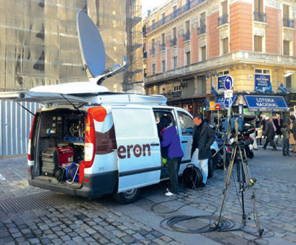
FIGURE 17.1
Traditionally, microwave or satellite trucks were used to send a video program or live television broadcast feed back to a station or network.
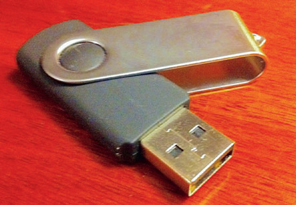
FIGURE 17.2
Large USB thumb drives are great for storing video files.
17.3 ONLINE DISTRIBUTION
Online distribution allows programming to be distributed worldwide. This has opened up access to people and markets that were unreachable in the past. Online sites provide a variety of opportunities for sharing video. Videos can be distributed to anyone, specific groups, or become part of a channel. It is possible to view SD, HD, 3D, and even VR (virtual reality) video on many of these websites. Users can upload videos from computers and mobile phones.
Video-sharing websites allow users to upload, share, and view productions. Some of the sites allow commercials, and others don’t. Some video-sharing sites are provided by private companies and are aimed at a specific audience. Others, like YouTube, Vimeo, and Facebook, are mass communication websites used by millions around the world (Figure 17.3). Facebook alone has over 1.6 billion active users around the world, with 8 billion daily video views. Websites differ greatly on how they manage their content. Some enable producers to upload their programs for free and make it available free to the audience. Other sites may charge a fee to view the video, splitting the fees between the site and the producer (Figure 17.4).
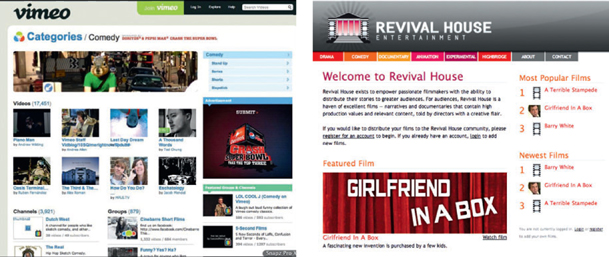
FIGURE 17.3
YouTube and Vimeo are some of the largest video-sharing websites. The second image is of a private website that distributes videos to a specific audience. In this situation it is distributing short films to university students. These video-sharing sites enable producers to distribute their material around the world.
YOUTUBE STATISTICS
■ YouTube has over a billion users—almost a third of all people on the Internet.
■ Every day, people watch hundreds of millions of hours of YouTube videos and generate billions of views.
■ 80 percent of YouTube’s views are from outside of the US.
■ YouTube has launched local versions in more than 88 countries.
■ You can navigate YouTube in a total of 76 different languages (covering 95 percent of the Internet population).
■ More than half of YouTube views come from mobile devices.
■ As of March 2015, creators filming in YouTube Spaces have produced over 10,000 videos, which have generated over 1 billion views and 70+ million hours of watch time.
(Source: YouTube)
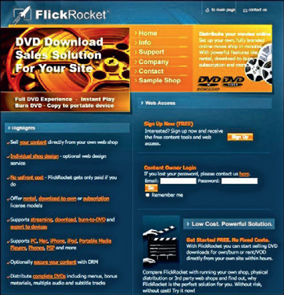
FIGURE 17.4
Some websites provide videos for a fee, splitting the fees between the site and the program’s producers.
17.4 LIVE ONLINE DISTRIBUTION
The Internet and mobile phones have incredibly changed the live distribution of content in other ways. In the past there were lots of layers of bureaucracy (gatekeepers) between the producer and the audience. As mentioned earlier, the cost of live transmission gear was also prohibitive. Today you can reach a live audience directly, going around the traditional gatekeepers, by using a computer or some mobile phones (Figures 17.5, 17.6, and 17.7).
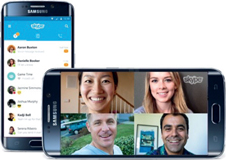
FIGURE 17.5
Some companies, like Skype, provide cell phone apps that enable live video transmission, including video from multiple sources.
As with video-sharing websites, live video streaming of events can be provided to a specific audience or made available to anyone who would like to see it. Video streaming requires substantial compression of the data, which often results in a lower-quality image. However, the quality is rapidly improving. Some live streaming sites allow unlimited viewers, while others, such as Apple’s Face Time, are currently limited to one-on-one direct video transmissions.
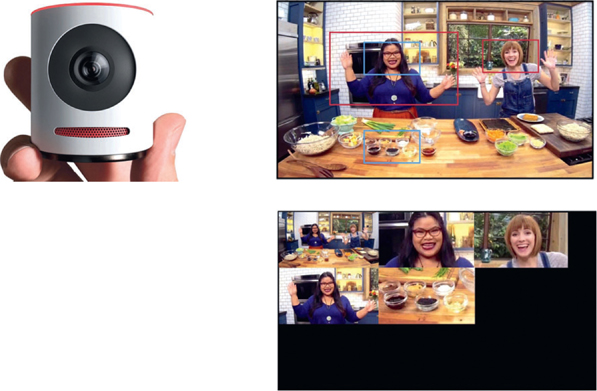
FIGURE 17.6
The Mevo camera utilizes a 4K chip, allowing the user to select portions of the image, which are able to be output as HD. The live switching app is used to select the live images can be used on a mobile phone or tablet, providing “live editing.” This was one of the first cameras that could provide a live video feed to Facebook.
(Photo courtesy of Livestream)
WHAT IS PERISCOPE?
Periscope lets you broadcast live video to the world. Going live instantly notifies your followers who can join and make comments.
Additional features:
■ When your broadcast is over, you can make it available for replay so viewers can watch later.
■ If you want to broadcast to specific people, press the lock icon before going live and choose who you want to invite to your broadcast.
■ You can choose to share your Periscope broadcasts on Twitter by tapping the bird icon before you start broadcasting. When you go live, you’ll tweet a link so that your Twitter followers can watch on the web (or in the app).

FIGURE 17.7
There are a number of apps that provide live video transmission as well as allow incoming comments from viewers on the screen.
(Photo courtesy of Periscope)
17.5 INTERNET PROTOCOL TELEVISION (IPTV)
Internet Protocol Television (IPTV) utilizes the Internet to provide programming to its audience instead of broadcast or cable television. IPTV is somewhat of a mix of the services by video-sharing sites and live streaming sites. Programming can be streamed live, VOD, or interactive television (iTV). Many times these systems are subscriber-based, which requires the payment of fees in order to access the content.
For example, Major League Baseball began its own IPTV called MLB.com. They provide baseball information, news, sports columns, and statistics. MLB.com also provides games, video and audio streaming of baseball games, official baseball fan products, and ticket sales (Figure 17.8). Some of their information is free, while other material is only available to subscribers. These sites provide an interactivity that gives much more access to the information the audience wants—allowing the viewer to individualize their viewing experience (Figure 17.9).
17.6 3G/4G TRANSMISSION
A growing method of video transmission by professionals in broadcasting is the use of 3G/4G cellular connections. In order to obtain a high-quality transmission, these units have to bond multiple 3G/4G cellular lines. The result is quality video transmission, ease of use, and the transmission systems are becoming incredibly small (Figure 17.10).

FIGURE 17.8
IPTV channels, like Major League Baseball, provide a wide range of services, often interactive, such as live streaming of games, baseball statistics, merchandise, and baseball news.

FIGURE 17.9
The Professional Golf Association (PGA) provides an app for mobile phones that allows viewers to customize their viewing. This includes receiving alerts when a specific player is at the tee. The apps enable you to follow a specific person without watching everything, as well as provide updated statistics, show the holes, or even watch a specific hole.

FIGURE 17.10
HD video can be transmitted utilizing multiple “bonded” cellular channels. The blue backpack is the 3G/4G transmission system.
(Photo/illustration courtesy of LiveU)
17.7 FESTIVALS AND COMPETITIONS
Video competitions and “film” festivals can also be a very productive way of getting your project seen. Productions are often exhibited in front of a live audience, providing a way for general viewers and distributors to see the production.
Summary
Television production personnel are having to learn how to use the new production media as they continue to emerge and converge. Producers need to know how to attract an online audience, including how to use social media to get the word out.
Chad Crouch, CEO, The Creative Group
How do you use online distribution of your videos?
I use the Internet as the main marketing tool for my company. Additionally, many of our clients hire us to help create effective, interactive websites for their organizations and companies. One of our long-term clients has seen significant results, attracting millions of visitors and empowering their political grassroots activism.
Why do you create things for the web?
It is the marketplace for the world. It is the best place to define what makes you unique and valuable.
What changes do you see in the future for online distribution?
Faster connection speeds will allow for higher-quality video files to be downloaded in short periods of time. The Internet will become the main distribution for traditional television programs and movies. I believe that the traditional “Internet” as we now understand it will be replaced with a new means of transferring data that will move us outside of the current limits. We will be constantly connected, without wires, any place at any time.

FIGURE 17.11
Chad Crouch, CEO, The Creative Group.
What challenges do you have to deal with when putting material online?
People have a very limited attention span when viewing content online. You have to design online content so that it is compelling, informative, and brief. This is a challenge for most organizations and companies. A large part of our relationship with clients is helping them refine their message so that it will communicate effectively online.
Chad Crouch is the CEO of a production and marketing company that works with corporate clients as well as nonprofit organizations.
